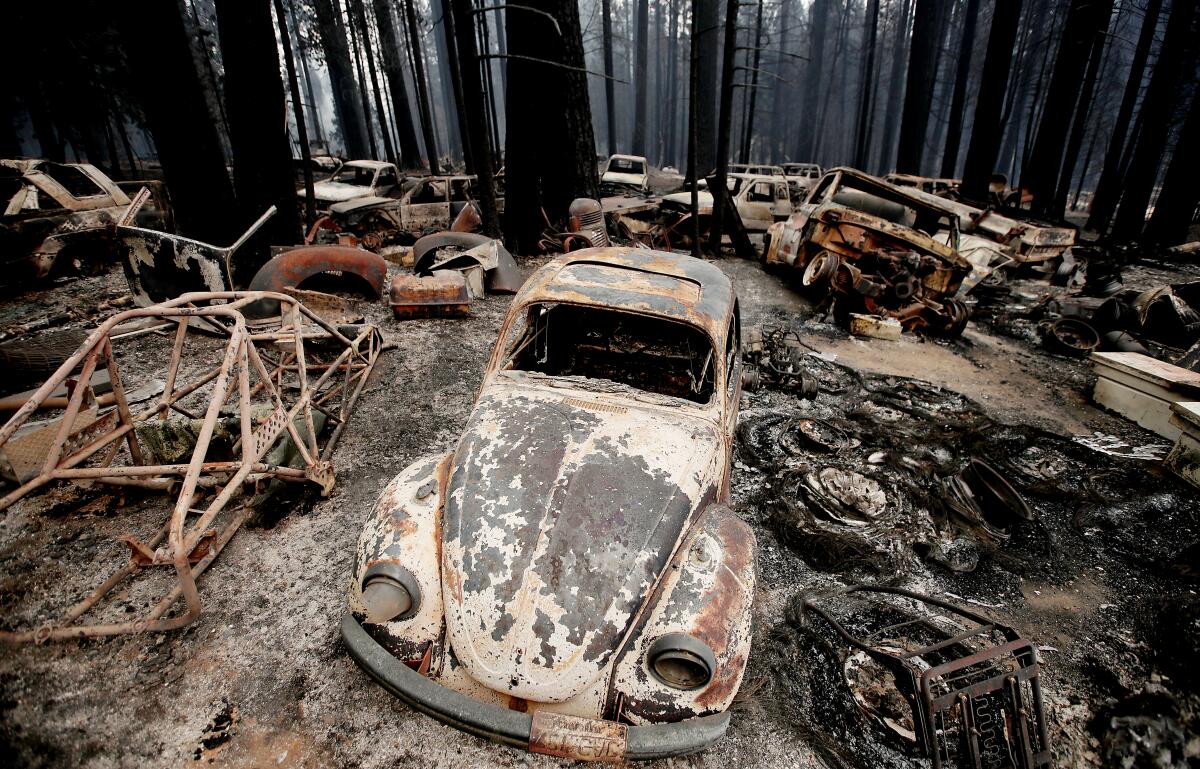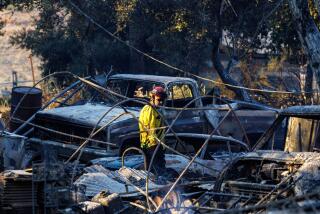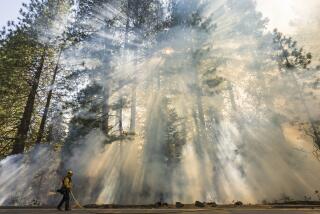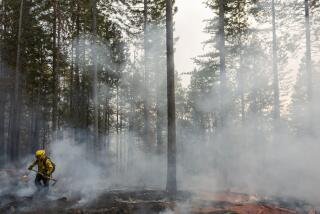Caldor fire in El Dorado County explodes to nearly 63,000 acres

The Caldor fire in El Dorado County has exploded to nearly 63,000 acres, destroying a school, a church and numerous other structures.
Thousands of rural residents fled the flames, and two civilians were seriously injured Tuesday as the fire tore through rugged terrain with zero containment.
By Wednesday night, the Caldor fire had burned 62,586 acres, according to an update by the California Department of Forestry and Fire Protection.
The fire continued to burn in steep terrain, fueled by âlarge amounts of dry vegetation,â according to Cal Fire. Firefighters noted growth throughout the active burn area, with the most growth occurring south of U.S. Route 50, which is also known as the El Dorado Freeway.
Caldor fire response spokesperson Chris Vestal said the blaze exhibited unusually high flame lengths and rapid spread. An incident report described its behavior as âunprecedented.â
On Wednesday, the Dixie fire also continued to rage, growing to more than 635,000 acres and threatening the communities of Janesville and Susanville in Lassen County, along its eastern edge.
In Lake County, the Cache fire broke out about 1 p.m., quickly expanded and prompted evacuations. By late evening, officials said its progress had been stopped but several mobile homes had been destroyed.
The Caldor fire has been burning since Saturday evening after igniting roughly four miles south of Grizzly Flats and two miles east of Omo Ranch. The cause remains under investigation.
It was at about 1,300 acres Monday afternoon when it began surging because of changes in atmospheric conditions.
Pushed by gusty winds, the fire hurtled north, and âunfortunately in the path of that fire has been communities,â said Mike Blankenheim, unit chief for Cal Fireâs Amador-El Dorado Unit.
Grizzly Flats and Leoni Meadows were âheavily impacted,â with structures destroyed, though the full extent of the damage is unknown, he said during a community meeting.
The topography has also posed challenges, making it difficult to create containment lines, Vestal said.
By Wednesday morning, the fire burning east of Sacramento had swelled to 53,772 acres, up from about 6,500 acres the previous morning.
âWeâre having to use a lot of hand crews versus some of the heavier machinery,â he said. âThey just canât access some of the canyons and terrain.â
Authorities issued several evacuation orders and warnings for surrounding communities as the fire raged. Details are available on the El Dorado County Sheriffâs Office Facebook page.
U.S. Forest Service officials issued an emergency closure of the Eldorado National Forest, citing the Caldor blazeâs âextreme fire behaviorâ and risks to both firefighters and the public.
As with other fires in Northern California, historically dry fuels and drought conditions are feeding the flames.
A forecast of gusty winds prompted the National Weather Service to extend a regional red flag warning until 8 p.m. Thursday.
The strongest winds are expected to hit the northern Sacramento Valley, with gusts up to 40 mph, the weather service said in a tweet. An overnight wind shift has filled the valley with smoke from several large area fires, affecting air quality in some places.
Pacific Gas & Electric cut the power of more than 48,000 residents across 13 Northern California counties on Tuesday evening amid high winds, fearing that the gusts could blow debris into energized power lines and ignite new blazes.
Power restoration for some areas began Wednesday and was expected to take up to 24 hours, a spokesperson said.
Amid gusty winds, the monstrous Dixie fire â the largest single wildfire in California history â grew to 635,728 acres by Wednesday morning. After burning for more than a month, it remains only 33% contained.
The massive fire that leveled a Gold Rush town has destroyed 1,200 structures, including more than 600 homes, making it the 14th most destructive fire in state history.
Flames on Wednesday neared Susanville â Lassen Countyâs biggest and only incorporated city â and a place of refuge for many fire evacuees. Authorities are on high alert, and some residents in surrounding areas have been ordered to leave.
Dan Newton, the interim city administrator for Susanville, lives just west of the city line and was ordered to evacuate Monday.
He is staying with a friend in town while his wife and two adult children stay in Chico.
Amid the evacuations, âIâm definitely â Iâm just one of many,â he said, his voice cracking with exhaustion.
âUnfortunately, weâre somewhat becoming used to this. We had to do this last year as well.â
Last summer, the Hog fire and Sheep fire burned near Susanville, creating burn scars that can be seen from town.
On Wednesday, he said, the winds seemed to be in the cityâs favor, and âin Susanville, the sky is blue for the first time in weeks.â
But even that was hard to celebrate, he said. If the winds are good for Susanville, they might mean the fire is headed for another community.
There were no immediate plans as of midday Wednesday to evacuate two state prisons in Susanville that house approximately 5,400 inmates. Together, the California Correctional Center and the adjacent High Desert State Prison provide more than 45% of the employment in Susanville.
âAt this time, there are no directives to evacuate, and the institutions are in no immediate danger,â Dana Simas, a spokeswoman for the California Department of Corrections and Rehabilitation, said in a written statement.
Officials also are monitoring air quality and providing N95 masks to staff and inmates at both prisons.
The institutions, Simas said, âhave long-standing response plans in place to ensure continued daily operations, as well as the safety of our staff and incarcerated population through natural or other disasters.â
Another prison in Lassen County â FCI Herlong, a federal prison about 30 miles southeast of Susanville â is also increasingly close to flames.
Donald Murphy, a spokesperson for the Bureau of Prisons, said in a statement that the agency is monitoring environmental conditions around the facility, which houses nearly 1,400 inmates, âas one of our highest priorities is the safety of both staff and inmates.â
He said the prison has contingency plans in place and will react to the emergency as needed.
Most of Janesville was spared Monday, as firefighters steered the flames around the community, but some structures burned, and authorities issued evacuation orders for the area.
Through Tuesday night, the fire continued to spread south along the Highway 395 corridor, and firefighters were still working to protect structures Wednesday morning, officials said.
Several other wildfires are ravaging Northern California, including the Monument and McFarland fires, which are burning northwest of the Dixie fire and were sparked in late July by lightning.
The Monument fire in Trinity County had seared 128,613 acres by Wednesday morning. It remains just 10% contained after burning for nearly three weeks.
To the south, the McFarland fire â impacting Shasta, Trinity and Tehama counties â ballooned to 107,102 acres and was 51% contained by Wednesday.
More than 10,000 firefighters are attacking 12 active large wildfires across California that have burned more than 1.3 million acres, according to Cal Fire.
Over 6,000 personnel are fighting the Dixie fire alone. The simultaneous blazes are stretching limited resources, according to fire officials.
Vestal said a huge order for resources has been made for the Caldor fire, and more equipment is on the way.
âSome of those are being filled,â he said. âSome of them are just harder to get right now as different incidents all over Northern California have priority needs.â
More to Read
Sign up for Essential California
The most important California stories and recommendations in your inbox every morning.
You may occasionally receive promotional content from the Los Angeles Times.













